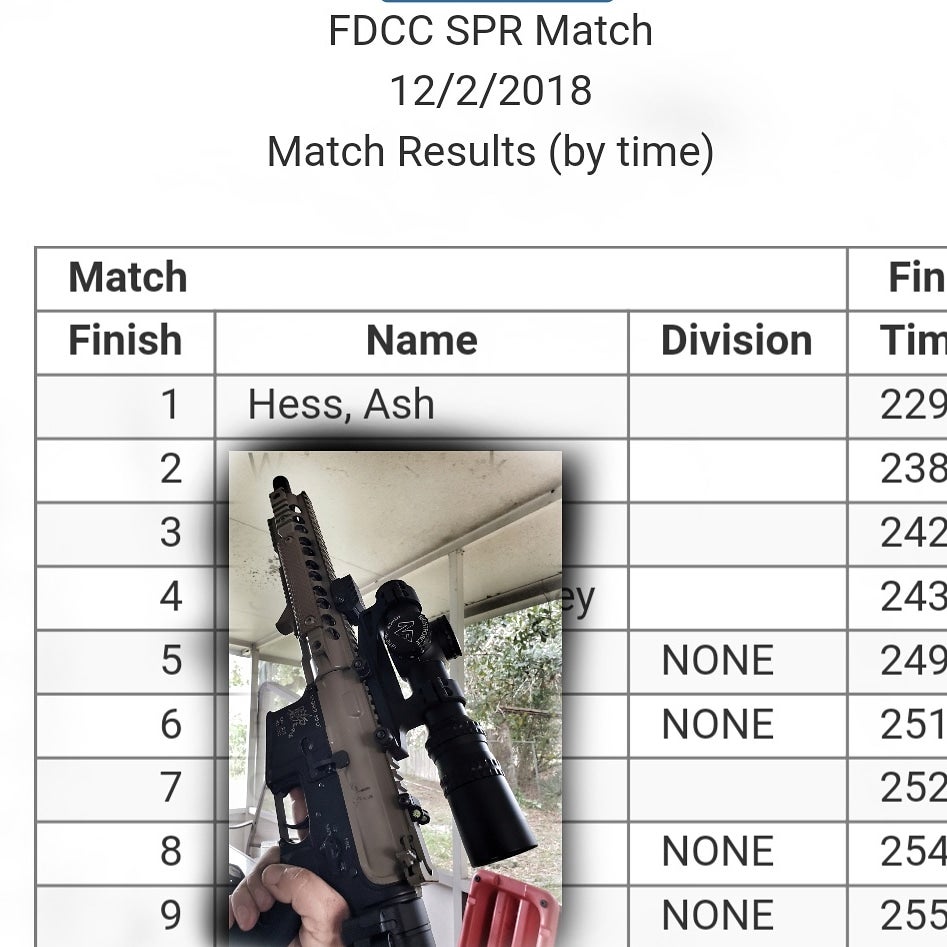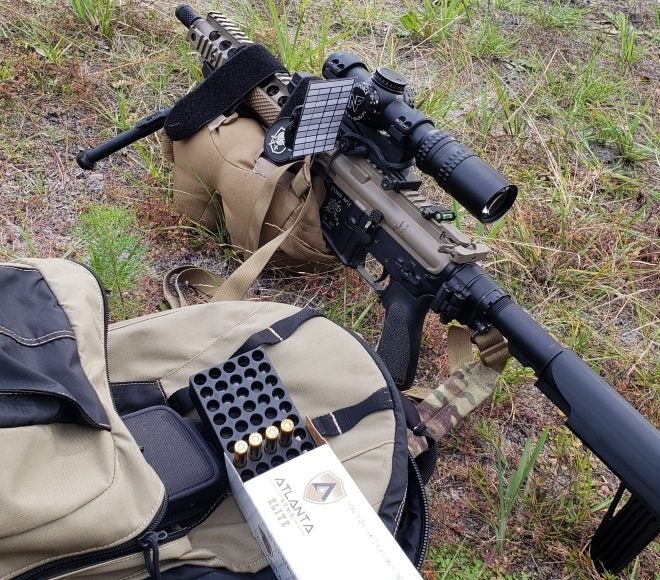I was recently contacted by Corey Wardrop, Knight’s Armament Company employee and a former TFB TV videographer, who said that he has a story that might be interesting for TFB readers. Of course, I was all ears and when I learned that Ash Hess, one of Corey’s colleagues at KAC, won a DMR match with an SBR, it was immediately clear for me that this is indeed a story that I need to tell to our readers. Corey kindly introduced me to Ash. We discussed the story and came to a conclusion that the best way to convey all its nuances is to have it told by Ash himself. So, below I’ll present you the interview with Ash Hess.

TFB: Ash, thank you for taking the time to answer our questions. Let’s start with telling our readers who is Ash Hess? Tell us a little bit about you.
AH: Well, I recently retired after 22 years of service from the US Army. From 2012 until 2018 I spent every day trying to improve marksmanship across the Army. That path started in 2005 when I attended the 10th Mountains marksmanship course followed by a deployment as a Squad Designated Marksman. Those two things showed me that our marksmanship needed help. After my fourth and final trip overseas I got the honor of rebuilding and improving the very school I attended years before. During the three years my team and I trained 2000 Soldiers and learned some great things about shooting. The hold up though for the Army was the doctrine itself. It didn’t lead to or support modern techniques and hadn’t been updated to match what we had learned in years of combat. This led to getting in contact with the Maneuver Center in Fort Benning and attempting to work with them to update the manual. As short time later, the Army decided to assign me to Fort Benning and ultimately, I was charged with updating TC 3-22.9 for the Army. With the help of a great number of friends and an amazing editor, we did just that.
Following the Army, I wanted to do something to remain relevant in the shooting side the community and I got into the Precision Rifle Series Gas Gun Tactical. I shot three major matches last season with a high placement of 5th which put me in 5th in the 2018 standings. I used the LPR for that and wished for more barrel on several occasions.
TFB: So you managed to win a DMR match with an SBR! Congratulations on that unbelievable achievement. What competition was it and how was it possible to enter it with such a different weapon?
AH: It was a pistol actually. While it was a DMR match, it sounds a whole lot cooler than it really was. The Florida Defensive Carbine Club does a five stage match focused on SPR/DMR type shooting every three months. It is precision focused but not nearly as hard as a PRS Gas gun match due to range limitations. Knowing this, I wanted to do two things. I wanted to highlight the capabilities of 5.56 even in short barrels and make myself work harder for practice for the bigger matches. Many folks tend to think that short guns are inaccurate or limited. It was a great opportunity to show the opposite of that. By going short, I would have to use holds that I would normally be using at greater distances with my Knight’s Armament Company Light Precision Rifle (LPR).
TFB: Please describe the weapon you used. What kind of rifles was it competing with?
AH: I used what could be considered a Knight’s Armament CQB Mod 1 which has an 11.5” barrel. It is more of a Knight’s Frankengun though. It has a CQB Mod 1 SR-16 upper on an Old School Non-Ambi Vero Beach era Stripped lower filled with KAC trigger with a Gearworks Tailhook Mod 2 brace. I managed to convince C. Reed Knight III to sell me the lower because I wanted something with some nostalgia to it. Knight’s moved from Vero Beach, FL to Titusville long before I started working there so its pretty cool. It was also assembled, used, abused, and disassembled by some of my mentors in and out of the company.
I am very particular on optic selection so for this match I used a Nightforce 1-8 ATACR in a KAC Mount.
Rifles varied from SBR’s and Pistols to full on MK12s and Special Purpose Rifles. You could call most of them coming from the Recce genre that came from the GWOT that had users with light 5.56 rifles set up for reconnaissance and high precision without going to 30 caliber rifles. The LPR I mentioned was built for this role specifically. There were some very, very nice rigs out there that day.
I used Atlanta Arms 75 grain Elite which I also used last season.

TFB: Why did you decide to take part in a DMR match with a rifle that was way inferior (in terms of range) to what many other participants would be using? Did you have a plan and predicted the victory or was it purely an experiment?
AH: Like I said, it was for the challenge. Of course, I wanted to win but prediction was to not be last. I knew I would beat someone on the hopes of reliability and a zero alone. Almost without fail, someone will show up to a local match without a zeroed rifle. PROTIP Don’t be that guy or you will get beat every single time.
Knowing the range restrictions, the 11.5 was within the parameters of the match. It prints just over a minute from the prone but looks really goofy wearing a bipod. The furthest target was a plate rack at 400 yards, but the 100-yard target was the toughest shooting of the match. The targets were 2 MOA and the stage had serious time constraints. That stage really separated the field. That’s why it isn’t as cool as it sounds for the DMR match because the rifle really was capable.
I knew if I could get stable enough, I would have a fighting chance. So many people don’t take the time to get a good understanding of ballistics. If you take the time and know where your bullet is in flight, you will see that even an 11.5-inch blaster is plenty of gun for most applications. I was running at about the edge capability, which was my plan. Had there been targets at greater distances or high winds I would have been wishing for the 500 feet per second I gave up from the LPR.
TFB: How exactly did you win? Were you faster or more accurate than others?
AH: Pure luck. Despite it not being a major match, the 25 people in the field were great shooters. The key is to go fast when you can and go slow when you must. I try to observe every shooter as they do their work. The biggest thing I see and try to avoid is moving slow and shooting fast. If you are slow getting into position or mounting the gun and shoot fast to make up for it, things don’t go as planned. The best move fast and shoot fast accurately. I am still working on that part. When its time to run, RUN. Every stage has different parameters for success.
Having a firearm that is zeroed and runs is a must. I haven’t been to a match yet where someone hasn’t had a malfunction or a sight adjustment error that cost them a stage. I have done it myself.
TFB: What do you think was the key to your victory – the weapon and equipment or your skills and experience or the combination of these factors?
AH: Here is where I will bring up the US Army’s manual again. In that book we laid out The Shot Process. The basis is there are things that you do at a certain point in each shot. First you get the firearm stable followed by aim. If you try to aim before you get stable you can’t hold the sights on the target. After you get stable enough to aim, you hold that aim while you manipulate the trigger to fire the round. Follow-through is simply seeing if the bullet had the desired effect and observing what you need to change to move on. It could be an adjustment or seeing the hit.
This is what I do. I have my shot process laid out and memorized. Every shot is its own individual event. Good or bad, it doesn’t matter. What matters is the next shot. I just try to make every shot the best I can possibly make it. Knowing what to do at each phase of the process comes with experience. For stability, I use Armageddon Gear bags to augment my position. For aiming, the reticle choice and knowing your data is important. Trigger control helps to not disturb the aim. All these things flow together with a practiced shot process.
TFB: What are you planning to do next … winning a PRS match with a snubby?
AH: Ha I wish. Those guys are so good I need something bigger, faster, and guided to beat them. Next is running our own match. Jack Leuba and I are putting on a match on the 30th of March. Details can be seen at Ash Hess-Pro Page on Facebook and registration is at www.arenatrainingfacility.com
Ash, thank you for this interview and once again congratulations on the victory. I am looking forward to hearing about your next unbelievable achievement.

To me, this is a great example of what one can achieve by knowing and understanding the capabilities of his weapon system and being able to efficiently utilize everything that his equipment can potentially offer. Good weapon and gear combined with the high level of shooter’s skills are a recipe to results that would be otherwise considered unrealistic or even impossible.
 Your Privacy Choices
Your Privacy Choices
